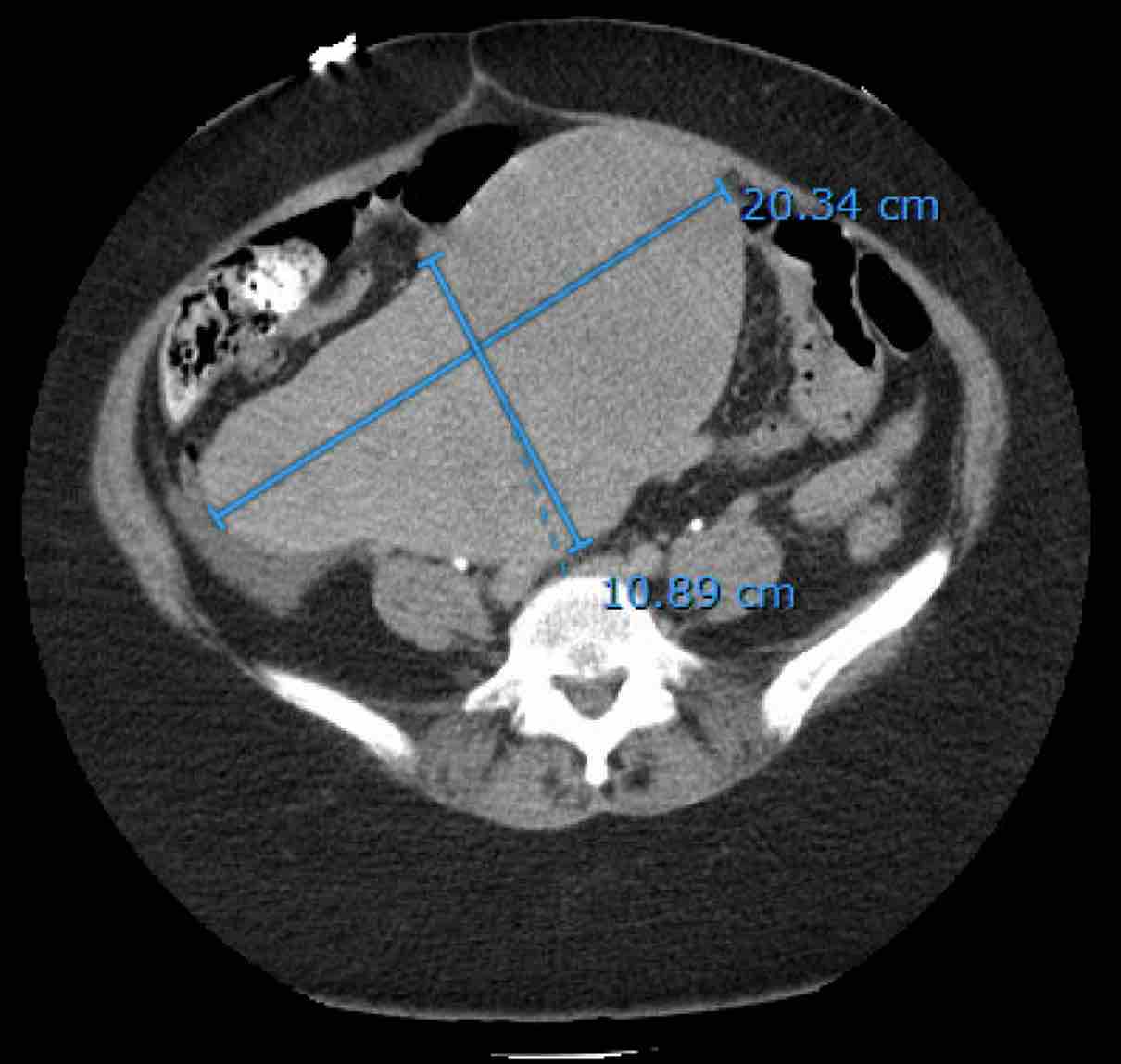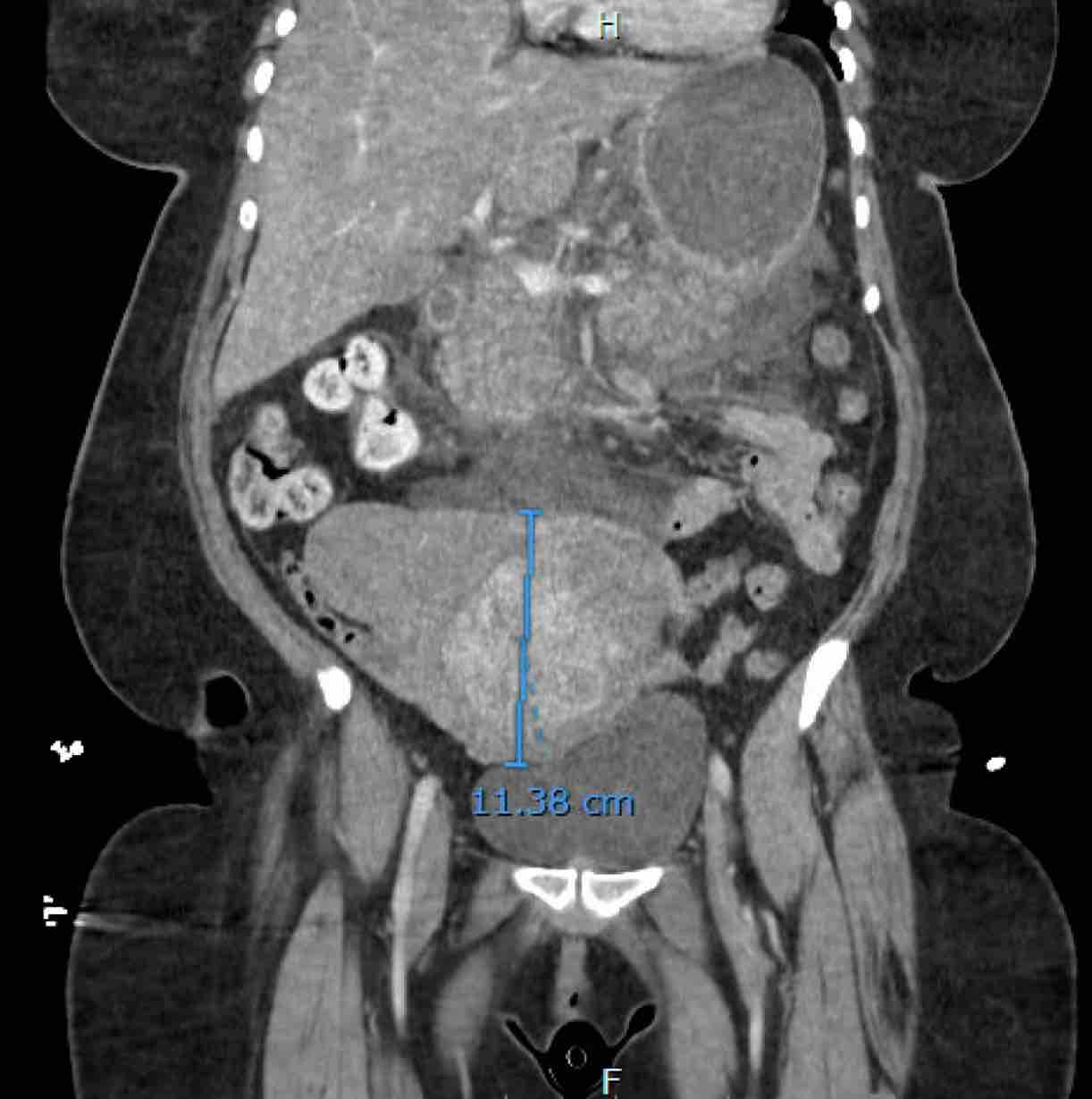Tuesday Poster Session
Category: Biliary/Pancreas
P4418 - From Heavy Menstrual Bleeding to Hypercalcemia-Induced Pancreatitis: The Unseen Connection
Tuesday, October 28, 2025
10:30 AM - 4:00 PM PDT
Location: Exhibit Hall

Bhaavya Pinnala, MD
Piedmont Macon Hospital
Cumming, GA
Presenting Author(s)
Bhaavya Pinnala, MD, Saleha Asghar, MD
Piedmont Macon Hospital, Macon, GA
Introduction: I present a case with acute pancreatitis from hypercalcemia due to excessive chalk ingestion due to pica, driven by heavy menstrual bleeding from uterine leiomyoma.
Case Description/
Methods: A 51-year-old African-American female with newly diagnosed DM2, presented with altered mentation, appeared pale, generalized weakness, vomiting, and increasing lethargy over the last 4 days. On assessment, she was found to be hypotensive, tachycardic, and hyperglycemic with a blood glucose level of 679 mg/dL. Laboratory results revealed elevated calcium of 25.4 mg/dL, lipase- 1739 U/L, and an ABG showing metabolic alkalosis. Imaging of the head and chest showed no acute findings, but abdominal/pelvic CT revealed pancreatitis and a large pelvic mass consistent with uterine leiomyoma. Subsequently, she was admitted to the ICU and received 2 total hemodialysis sessions, fluids, and calcitonin with eventual resolution of hypercalcemia. Prior to the resolution, an extensive workup for hypercalcemia was obtained. This included a low PTH level of 5.9 pg/mL and low phosphate levels of 1.5 mg/dl and other tests were unremarkable- ruling out malignancy, sarcoidosis, and parathyroid disorders. However, the CBC revealed a Hgb of 6.5 g/dl, MCV of 63, iron level of 8 µg/dL, normal ferritin, and reticulocyte levels, and a blood smear showing microcytic anemia. She also denied the use of thiazides, antacids, and vitamin D supplements. Once the encephalopathy improved, patient was asked if she consumed anything unusual, to which she revealed that she ate multiple bags of chalk every day. She eventually received IV iron and was discharged with iron supplements and a follow-up with Gynecology.
Discussion:

Figure: Image 1: Patients CT scan abdomen/pelvis- showing the uterine mass.

Figure: Patients CT scan abdomen/pelvis- showing the uterine mass.
Disclosures:
Bhaavya Pinnala indicated no relevant financial relationships.
Saleha Asghar indicated no relevant financial relationships.
Bhaavya Pinnala, MD, Saleha Asghar, MD. P4418 - From Heavy Menstrual Bleeding to Hypercalcemia-Induced Pancreatitis: The Unseen Connection, ACG 2025 Annual Scientific Meeting Abstracts. Phoenix, AZ: American College of Gastroenterology.
Piedmont Macon Hospital, Macon, GA
Introduction: I present a case with acute pancreatitis from hypercalcemia due to excessive chalk ingestion due to pica, driven by heavy menstrual bleeding from uterine leiomyoma.
Case Description/
Methods: A 51-year-old African-American female with newly diagnosed DM2, presented with altered mentation, appeared pale, generalized weakness, vomiting, and increasing lethargy over the last 4 days. On assessment, she was found to be hypotensive, tachycardic, and hyperglycemic with a blood glucose level of 679 mg/dL. Laboratory results revealed elevated calcium of 25.4 mg/dL, lipase- 1739 U/L, and an ABG showing metabolic alkalosis. Imaging of the head and chest showed no acute findings, but abdominal/pelvic CT revealed pancreatitis and a large pelvic mass consistent with uterine leiomyoma. Subsequently, she was admitted to the ICU and received 2 total hemodialysis sessions, fluids, and calcitonin with eventual resolution of hypercalcemia. Prior to the resolution, an extensive workup for hypercalcemia was obtained. This included a low PTH level of 5.9 pg/mL and low phosphate levels of 1.5 mg/dl and other tests were unremarkable- ruling out malignancy, sarcoidosis, and parathyroid disorders. However, the CBC revealed a Hgb of 6.5 g/dl, MCV of 63, iron level of 8 µg/dL, normal ferritin, and reticulocyte levels, and a blood smear showing microcytic anemia. She also denied the use of thiazides, antacids, and vitamin D supplements. Once the encephalopathy improved, patient was asked if she consumed anything unusual, to which she revealed that she ate multiple bags of chalk every day. She eventually received IV iron and was discharged with iron supplements and a follow-up with Gynecology.
Discussion:

Figure: Image 1: Patients CT scan abdomen/pelvis- showing the uterine mass.

Figure: Patients CT scan abdomen/pelvis- showing the uterine mass.
Disclosures:
Bhaavya Pinnala indicated no relevant financial relationships.
Saleha Asghar indicated no relevant financial relationships.
Bhaavya Pinnala, MD, Saleha Asghar, MD. P4418 - From Heavy Menstrual Bleeding to Hypercalcemia-Induced Pancreatitis: The Unseen Connection, ACG 2025 Annual Scientific Meeting Abstracts. Phoenix, AZ: American College of Gastroenterology.
